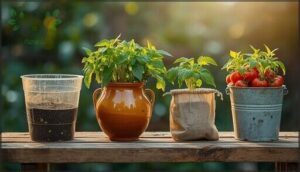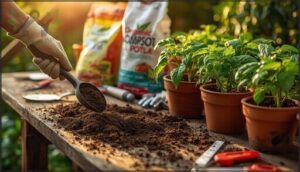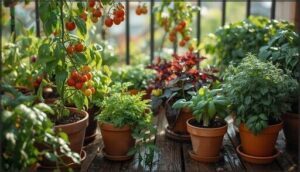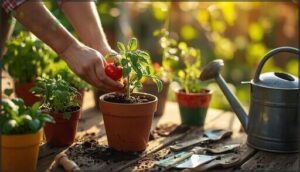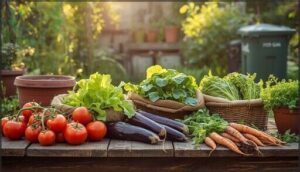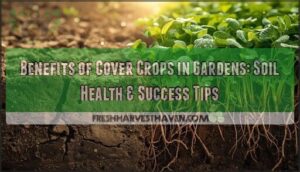This site is supported by our readers. We may earn a commission, at no cost to you, if you purchase through links.
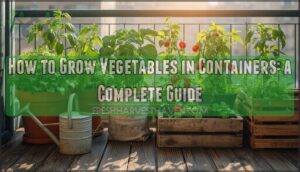
Container gardening gives you control over soil quality, placement, and growing conditions in ways traditional gardens can’t match. Plus, you can move plants to chase sunlight or protect them from harsh weather. Whether you’re working with a small apartment balcony or a sunny deck, containers open up possibilities for homegrown food.
The key is understanding which containers work best, what soil to use, and how to care for plants in confined spaces.
Table Of Contents
- Key Takeaways
- Choosing Containers for Vegetable Gardening
- Selecting The Right Soil and Fertilizer
- Best Vegetables for Container Growing
- Planting Vegetables in Containers
- Caring for Container Vegetable Gardens
- Harvesting and Sustainability Tips
- Frequently Asked Questions (FAQs)
- Can you grow vegetables in containers?
- What vegetables grow well in containers?
- What can you grow in a container garden?
- How do you grow a vegetable garden in a container?
- What is vegetable container gardening?
- What size container do you need to grow vegetables?
- What vegetables grow best in containers?
- What do you put in the bottom of a vegetable container?
- What is the most common mistake made with container plants?
- How deep do containers need to be to grow vegetables?
- Conclusion
Key Takeaways
- Container gardening lets you grow fresh vegetables in any small space—balconies, patios, or fire escapes—by using the right containers, quality potting mix, and proper drainage to control soil quality and growing conditions better than traditional gardens.
- Success depends on matching container size to your vegetables’ root depth needs: shallow crops like lettuce thrive in 6-8 inch pots, while tomatoes and peppers need 12-18 inches with at least 5 gallons of volume for healthy growth.
- Containers dry out faster than ground soil, so you’ll need to water deeply when the top inch feels dry—sometimes twice daily in hot weather—and feed plants regularly with balanced fertilizers since nutrients leach out quickly.
- Choose compact varieties bred for containers like patio tomatoes, bush beans, and dwarf peppers, then support vining plants with stakes or trellises to boost yields by up to 30% while keeping fruits off the soil.
Choosing Containers for Vegetable Gardening
Your container choice matters more than you might think. The right pot can make watering easier, keep roots healthier, and even help you move plants around as seasons change.
Let’s look at the materials, sizes, and features that’ll set your vegetables up for success.
Best Container Materials (Plastic, Ceramic, Fabric, DIY)
You have four solid choices regarding container materials. Plastic pots are lightweight and hold moisture well—about 70% of gardeners choose them for easy handling. Ceramic pots look great but weigh more. Fabric pots promote excellent root aeration and faster growth through air-pruning. DIY containers from recycled buckets work too, though you’ll need to drill drainage holes first.
Alternatively, gardeners might select glazed ceramic pots for their moisture retention.
Container Sizes and Depths for Vegetables
Material matters, but container size determines success. Shallow-rooted crops like lettuce thrive in 6–8 inch pots, while peppers and tomatoes need 12–18 inches for proper root growth. Deep-rooted crops such as potatoes demand 18–24 inches to avoid root restriction.
Ideal volume matters too—tomatoes require at least 5 gallons per plant. Larger containers mean healthier roots, better drainage impact, and less frequent watering. For growing broccoli, consider using a 5-10 gallon container.
Importance of Drainage Holes
You won’t get far without drainage holes—they’re non-negotiable. Root rot strikes when water pools, killing up to 65% of vegetables in sealed containers.
Drainage holes are non-negotiable—without them, root rot kills up to 65% of vegetables in sealed containers
Drainage holes also flush out salt buildup that burns leaf edges, improve soil aeration by 18%, and stabilize moisture regulation.
Studies show properly drained pots extend plant longevity by three weeks, proving prime drainage techniques directly impact your harvest success.
Selecting Containers for Mobility and Placement
Once drainage is handled, you’ll want containers that won’t trap you in one spot. Lightweight materials like plastic and fabric slash weight by 40–75%, making repositioning easy for sunlight adaptation.
Wheeled planters let you chase the sun without the backache—mobile setups gain 15–25% more light through seasonal moves.
Container height between 70–90 cm cuts bending by nearly half, perfect for choosing the right container when your back protests.
Selecting The Right Soil and Fertilizer
Your containers won’t do much good if you fill them with the wrong stuff. Vegetables are heavy feeders, so they need soil that drains well but still holds onto moisture and nutrients.
Let’s look at what works best for container growing and how to keep your plants fed throughout the season.
Potting Mix Vs. Garden Soil
Choosing potting soil over garden soil makes all the difference in container success. Potting mix is specifically designed for containers, reducing soil compaction and pathogen risks by up to 90% while improving moisture management.
Garden soil, though nutrient-rich, becomes too heavy and dense in pots, leading to waterlogging and root problems.
For best soil for container gardening, stick with quality potting mix for healthier plants.
Soil Depth Requirements
Without proper root depth, your vegetables won’t reach their full potential. Shallow-rooted greens need 6 to 9 inches of soil, while medium crops like peppers require 12 to 18 inches for adequate root development. Tomatoes and deep-rooted vegetables thrive in 18 to 24 inches.
Container size impacts moisture retention levels and prevents soil compaction effects that restrict growth, especially in mixed planting depths.
Organic and Balanced Fertilizer Options
You’ll need the right fertilizer to give your container vegetables the nutrients they crave. Organic fertilizers like blood meal, feather meal, and fish emulsion deliver nitrogen gradually, while balanced NPK formulas at 3–3–3 or 5–5–5 ratios support steady growth.
Apply dry fertilizers at 0.5 teaspoon per gallon every 3–4 weeks, or use slow-release options lasting 3–9 months for consistent plant nutrition.
Amending Soil for Nutrient Retention
Organic matter works like a sponge, holding soil nutrients right where your plants can reach them. Boost your potting mix with these amendments to reduce leaching and strengthen nutrient retention:
- Compost at 10–20% by volume increases cation exchange capacity (CEC), locking in calcium, potassium, and magnesium
- Vermiculite/perlite blends balance moisture with aeration while extending fertilizer availability
- Biochar at 5–10% delays nutrient release in container systems
Best Vegetables for Container Growing
Not all vegetables are created equal with regard to container growing. Some thrive in pots with little fuss, while others struggle without the space and depth of a traditional garden bed.
Let’s look at which vegetables work best in containers and how to choose varieties that’ll give you the most success.
Top Vegetable Varieties for Containers
Not every vegetable needs a full garden plot to thrive. Patio tomatoes like ‘Tiny Tim’ and ‘Patio Princess’ deliver impressive yields in just 5 gallons, while compact peppers such as ‘Gypsy’ and ‘Mini Bell’ produce 20–25 pods per plant.
Bush beans, container potatoes, and dwarf varieties of eggplant and cucumber make container gardening accessible and productive, proving that the best vegetables for containers are often those bred specifically for tight spaces.
Bush Vs. Vining Vegetables
Choosing between bush and vining vegetables comes down to space and patience. Bush varieties, like dwarf pea varieties, mature 10–14 days faster and fit 12-inch containers without support, perfect for beginners.
Vining types—pole beans, heirloom cucumbers—need trellises and larger pots but reward you with double the yield over months.
Match your container suitability and support needs to your space requirements for consistent harvests.
Growing Leafy Greens and Root Crops
Lettuce and other leafy greens thrive in shallow 6–8 inch containers with just four hours of sunlight daily, delivering continuous harvests for up to eight weeks.
Root vegetables like carrots and radishes need deeper 12-inch pots and good drainage—radishes mature in under five weeks.
Monitor soil moisture closely; containers dry out fast during hot weather, requiring daily watering to keep your harvest timing on track.
Adding Herbs to Your Container Garden
Beyond leafy greens and root crops, herbs round out your container garden beautifully. Herb selection matters—basil, parsley, and mint are grown by roughly 80% of container gardeners. A single 16-inch pot holds up to six plants, offering companion planting benefits and natural pest control.
Here’s what works best:
- Basil and parsley for culinary uses year-round
- Mint varieties contained to prevent garden invasion
- Thyme and rosemary for flavor retention
- Chives producing edible leaves for 7–9 months
- Winterizing herbs indoors extends your harvest 3–4 months
Keep containers in six hours of sunlight, water regularly, and you’ll enjoy fresh herbs all season.
Planting Vegetables in Containers
Once you’ve chosen your containers and soil, it’s time to get your vegetables in the ground. Whether you’re starting from seeds or picking up seedlings from the nursery, a few simple techniques will set your plants up for success.
Let’s walk through the key steps to get your container garden growing strong.
Choosing Seeds or Seedlings
You can start your container garden with either seeds or seedlings, and both have their perks. Seeds offer better variety selection and cost less, but seedlings give you a head start with stronger root development and seedling vigor.
If you’re new to growing vegetables in containers, seedlings reduce transplant shock and get you harvesting faster—especially important when seed viability might be uncertain.
Sowing and Transplanting Techniques
Whether you direct seed or use plant starts, sowing depth matters—aim for 0.25 to 0.5 inches for small seeds.
Seedling prep is simple: harden off transplants over 7–10 days with gradual outdoor exposure. Transplant timing counts, too—late afternoon works best.
Post-transplant, water lightly and use diluted fertilizer within the first week to help your seedlings settle in.
Proper Spacing in Containers
Proper spacing affects yield density and root expansion in containers. For leafy greens and root crops, you’ll want 2–4 inches between plants to support healthy development. Fruiting vegetables like tomatoes need 24–36 inches for best density and air circulation.
Container gardening also allows companion planting—basil fits nicely with tomatoes since their root zones differ. Vertical spacing matters too; deeper pots prevent crowding and boost yields.
Container Placement for Sunlight Needs
Sunlight exposure drives container garden success. Most vegetables need 6–8 hours of direct light daily, though leafy greens tolerate 4–6. South-facing spots deliver best orientation for fruiting crops, while east-facing areas suit cool-season varieties.
Watch for shadow management—trees and fences can cut light by 30–50%. Seasonal adjustments matter too; light intensity peaks midafternoon, so monitor microclimate benefits near reflective walls for enhanced growth.
Caring for Container Vegetable Gardens
Once your vegetables are planted, the real work begins. Container gardens need regular attention to stay healthy and productive, but the tasks are simple when you break them down.
Let’s walk through the core care practices that’ll keep your plants thriving from seedling to harvest.
Watering Techniques and Schedules
Getting water right makes all the difference in container gardening. Check soil moisture by testing the top inch—when it feels dry, it’s time to water.
During hot weather above 90°F, you’ll need to water daily or even twice daily. Always water deeply at the base until it drains through, which cuts disease risk by up to 43% and keeps roots healthy.
Supporting and Training Plants
Many container vegetables need structural assistance to thrive—without it, plants sprawl, fruits touch soil, and yields drop sharply. Trellises and stakes increase your growing space by up to 100% and boost yields by 30% in tomatoes.
Install structural aids at planting to avoid root damage, securing them deep for stability. Train vining crops like cucumbers, pole beans, and indeterminate tomatoes using single-string or cage methods for healthier plants and easier harvests.
Managing Pests and Diseases Organically
Pest and disease management doesn’t have to mean chemicals—container vegetables thrive with organic approaches that keep your harvest safe and healthy. You’ll get better results with regular monitoring and quick action:
- Biological controls like predatory mites eliminate up to 90% of spider mites naturally
- Organic sprays such as neem oil (0.25 tsp per 2 liters) reduce aphids by 75%
- Companion planting basil with tomatoes decreases pests by 40%
- Disease prevention starts with sterile potting mix, cutting fungal issues by 80%
- Cultural practices like proper spacing lower gray mold incidence by 50%
Pruning and Maintenance Tips
Pruning frequency is key to the success of container vegetables, distinguishing between mediocre and thriving plants. Weekly pruning of tomatoes can enhance yield consistency by up to 11%, while monthly care during growing seasons sustains overall plant health and productivity.
| Task | Impact |
|---|---|
| Remove diseased leaves | Cuts fungal risk 17% |
| Train vining plants | Increases fruit set 18% |
| Prune herbs regularly | Boosts leaf yield 23% |
| Stake top-heavy crops | Prevents stem damage 15–20% |
| Keep maintenance logs | Improves harvest rates 16% |
A well-structured maintenance schedule should incorporate daily inspections, strategic pruning to enhance airflow (which reduces disease by 13–27%), and training techniques that support heavy fruiting vegetables. By directing plant energy efficiently, resource optimization becomes a natural outcome.
Harvesting and Sustainability Tips
Harvesting your container vegetables at the right time ensures the best flavor and nutritional value. Once you’ve enjoyed your fresh produce, you’ll want to think about how to store it properly and prepare your containers for the next growing season.
You can also make your container garden more sustainable by reusing materials and understanding the environmental benefits of growing your own food.
When and How to Harvest Container Vegetables
Knowing when to pick your container vegetables makes all the difference between bland and wonderful flavor. Harvest leafy greens early in the day when moisture content peaks, and watch for color shifts in tomatoes and peppers as key ripeness indicators.
Use clean scissors for precision cuts, which promotes continuous production. Your harvesting methods directly influence yield outcomes, with most container vegetables delivering two to six harvestable cycles per season when you time it right.
Post-Harvest Storage and Use
After harvesting vegetables from your containers, quick action prevents nutritional changes and spoilage factors like moisture loss and decay. Storage loss rates climb when you delay proper handling, so immediately refrigerate salad greens and perishables. Extending shelf-life preserves those nutritional benefits you worked hard to grow.
Utilization trends show most container harvests get consumed fresh, though you can:
- Blanch and freeze beans and peas within hours
- Store root crops in cool, dark spaces
- Can tomatoes and peppers using proper techniques
- Dehydrate herbs for year-round flavor
Reusing Soil and Containers
Once you’ve enjoyed your harvest, you can stretch your resources by reusing soil and containers. Disease prevention starts with container sanitation—scrub pots with a 10% bleach solution, then air-dry completely.
Soil sterilization eliminates pathogens when temperatures hit 82–93 °F for 30 minutes. Nutrient recharging restores fertility by mixing compost at a 1:3 ratio with used potting mix, while adding perlite helps structure restoration.
Sustainable Practices and Environmental Benefits
Beyond recycling your supplies, container gardening delivers real environmental wins. Water conservation through drip systems cuts usage by 60%, while mulching boosts water retention.
You’ll promote biodiversity by attracting pollinators, achieve carbon reduction by growing local food, and support waste reduction when you compost kitchen scraps into organic fertilizer rich in soil nutrients.
Your containers even offer climate adaptability—just move them when weather turns rough.
Frequently Asked Questions (FAQs)
Can you grow vegetables in containers?
Yes, you can grow vegetables in containers with great success. Container gardening works perfectly for space limitations, offers beginner success with proper variety selection, and produces impressive yields when you meet basic needs.
What vegetables grow well in containers?
Picture a patio bursting with color and fresh food. Compact tomatoes, bush beans, dwarf peas, miniature cucumbers, and dwarf eggplant thrive in pots, making container vegetable selection easier than you’d think.
What can you grow in a container garden?
You can grow vegetables, herbs, and even compact fruit varieties in container gardens. Space maximization through vertical gardening and companion planting lets you cultivate microgreens, leafy greens, tomatoes, peppers, and more—even with balcony limitations.
How do you grow a vegetable garden in a container?
Start by choosing the right containers with drainage holes, filling them with quality potting mix, placing them where they’ll get plenty of sunlight, and establishing a consistent watering schedule for healthy growth.
What is vegetable container gardening?
You don’t need a sprawling backyard to enjoy fresh produce. Vegetable container gardening is the practice of growing edible plants in pots, enabling space-saving gardening on patios, balconies, or any sunny spot.
What size container do you need to grow vegetables?
Container size requirements vary by vegetable type. Shallow-rooted crops like lettuce need a minimum container depth of 6 inches, while deep-rooted tomatoes require 12 inches or more for proper root development and healthy yields.
What vegetables grow best in containers?
Best vegetables for containers include dwarf varieties like cherry tomatoes, bush beans, and compact peppers.
Choose plants with shallow root systems, high yield potential, and climate adaptability for successful container vegetable gardening and maximum space efficiency.
What do you put in the bottom of a vegetable container?
Proper drainage makes or breaks container success. Add a thin layer of gravel or broken pottery at the bottom to prevent waterlogging, improve soil aeration, and support healthy root development through effective drainage techniques.
What is the most common mistake made with container plants?
Poor drainage is the most common mistake. When containers lack adequate holes or use soil that holds too much water, roots suffocate, leading to root rot and stunted growth.
How deep do containers need to be to grow vegetables?
Most vegetables need at least 12 inches of container depth for healthy root development. Shallow-rooted greens thrive in 6-inch pots, but deeper containers improve drainage effects, root depth, and overall yield impact for larger crops.
Conclusion
Container gardening isn’t rocket science—it’s simpler than you think. You’ve learned the essentials: choosing the right containers, using quality potting mix, selecting suitable vegetables, and maintaining consistent care.
Growing vegetables in containers transforms any small space into a productive garden. Start with one or two plants, observe how they respond, and expand from there.
Fresh tomatoes, crisp lettuce, and fragrant herbs are within reach. Your balcony or patio can become a thriving source of homegrown food with minimal effort.
- https://extension.umn.edu/how/water-wisely-start-your-own-backyard
- https://store.almanac.com/container-gardeners-handbook/
- https://www.countryliving.com/gardening/garden-ideas/g4098/best-plants-for-container-gardening/
- https://www.diyncrafts.com/7137/food/35-easiest-container-pot-friendly-fruits-vegetables-herbs
- https://www.finegardening.com/article/10-plants-for-year-round-containers

